yeovil People
John & Thomas Swatridge
Early Yeovil Photographers
John Swatridge was born on 7 January 1810 at Beaminster, Dorset, the son of baker William Swatridge (b1781) and his wife Sarah (b1791). John was baptised at Beaminster on 28 January 1810. Nothing is known of John's early life but on 9 February 1836 he married Harriet Loring at Yeovil. In the announcement of their wedding in the Sherborne Mercury, both John and Harriet were noted as 'both of Yeovil'. Harriet, born in Axminster in 1816, was the daughter of William Loring and Kezia née Pierce. John and Harriet were to have three sons; Thomas Sydenham (1841-1909), Richard Waygood (1846-1879) and William (1848-1911).
John was a member of the Yeovil Vestry during the late 1830s and was first listed in a Yeovil trade directory in 1840 when he was listed as a Marble & Stone Mason of Cattle Market (today's Princes Street) and again in Middle Street, both in the Somerset Gazette Directory of 1840.
John was, however, an influential Yeovilian since in March 1846 he was appointed Overseer at the Annual Vestry, together with Thomas Busby, George Wellington and John Newman Berkeley. As a complete sidenote, in November 1847 John was summoned to be a member of the jury on the inquest of the death of Yeovil chemist George Wellington, his fellow Overseer, in which it was determined that Wellington was 'found drowned'.
In the 1841 census, John and Harriet and three-month old Thomas were living in Hendford (at the time this was the west side of today's Princes Street, near the corner of today's Westminster Street). Thirty year old John listed his occupation as a 'Carver & Gilder'. Living with them was a young carver's apprentice, a domestic servant and a nurse.
In 1850 John was listed twice in Hunt & Co's Directory of 1850; once as a 'Mason, Stone & Marble & Carver of Hendford' and also as a 'Stone & Marble Mason, Gilder of Hendford'. In all the above cases the Cattle Market and Hendford addresses were undoubtedly the same building shown in the gallery below.
In 1851, John was noted as an investor in the South Western Railway Company.
In the following 1851 census, it becomes clear that John's shop, which he lived above with his family, was situated in today's Princes Street (the western side between today's Westminster Street and Park Road was called Hendford). Now 5 and 7 Princes Street, the shop displays small carved faces - to denote John's skill in carving. In the census, John and Harriet, together with their three sons and a domestic servant, were living above the shop premises. John gave his occupation as 'Carver & Gilder & Statuary Mason employing 6 men, 1 apprentice and 3 boys'.
John was listed as a Stone and Marble Mason & Gilder of Hendford twice in Slater's Directory of 1852 and the Churchwardens' Accounts refer to him as a Marble Mason in 1855. These were the last listings of him in this trade although he undoubtedly carried on in this profession.
However, it must have been around this time that he became interested in photography and set up a photographic studio in his shop premises. There is no doubt that he considered himself a professional photographer as evidenced by the photographs illustrated below, which carry a professional logo on the reverse. At the same time, however, his son Thomas was also working as a photographer as seen by the advertisements of 1858 (when Thomas was just 17 years old) and 1860 below. Cartes de visite (also known as cartes or CDVs), were only introduced in Britain in 1859 but it appears that both John and Thomas Swatridge were using them within months of their introduction.
While the illustrations below are mostly credited to John Swatridge, it may be that his son Thomas was initially the photographer - he was only 17 when he first advertised himself as a photographer in 1858 and, presumably, was not old enough to be head of a business. However, it is known that Thomas had his own design for the backs of his cartes, initially reading "T Swatridge, Yeovil" under a combined TS logo (see below) and later "TS Swatridge, Photographer, Princes St., Yeovil".
The 1861 census shows John and Harriet, together with Thomas and a domestic servant living at Princes Street (this was still the same property previously described as being in Hendford, but the new name of Princes Street became commonly used at this time). At this time John gave his occupation as a carver and gilder, stone mason employing 5 men & 2 boys' with no mention of photography, while 20-year old Thomas gave his occupation as a photographer.
Thomas, however, was to leave Yeovil and it appears that a series of photographers were then employed by John Swatridge as owner of the photographic business. Photographers (usually referred to as 'managers') known to have worked for John Swatridge include James Francis (1863), Mr Neale (1866), Mr Porteus (1872) and William T Sugg (1866-1872).
On 9 November 1863, Thomas married Emma Rosetta Mary Verrals (Venables) in Westminster, London. They lived in Bristol between 1863 and 1867 where Thomas traded as a 'Hat and Cap Dealer, Photographer, Dealer & Chapman'. Unfortunately he was made bankrupt in 1868.
By the time of the 1871 census, Thomas and Emma, together with their 4-year old daughter Rosalina and Emma's widowed mother Elizabeth Venables, were living at 35 Balls Pond Road, Hackney. Thomas gave his occupation as a photographer and he is known to have had his studio at this address until at least 1877.
Harriett died in Yeovil in the spring of 1874 aged 59. John Swatridge, while visiting his son, died on 7 October 1876 in Chicago, Illinois, USA, aged 66. His statuary and monumental masons business was taken over by Cole & Son who were advertising in Whitby's Yeovil Almanack Advertiser from 1878 as 'late Swatridge'. In 1878, Adam Gosney purchased the photographic business of Cole & Son. The sale included not only the negatives of Cole & Son, but also John and Thomas Swatridge's negatives.
Thomas' later photographic studios were at 66 Church Street, Camberwell and also 50 Dalston Lane, Hackney (1877-1881) before moving to 3 Alfred Terrace, Holloway Road, Islington (1883-4). By the time of the 1901 census Thomas had retired and he died in Lambeth in 1909.

John Swatridge's signature against the Vestry minutes of 8 September 1836.
gallery

The notice of John Swatridge's appointment as Overseer in the 28 March 1846 edition of the Western Flying Post.
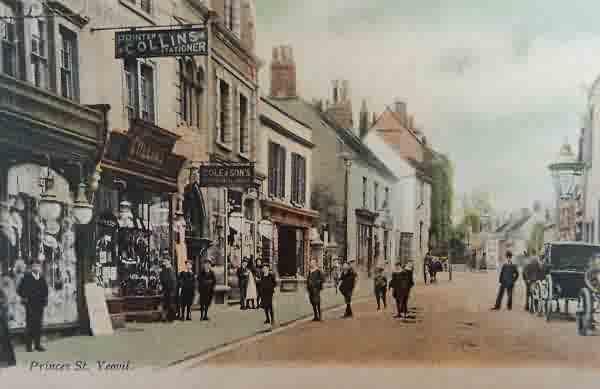
A postcard of Princes Street, dating to around 1905, published by printer William Beale Collins and showing his premises at left. The premises had earlier been those of Cole & Son and, prior to that, of John Swatridge.
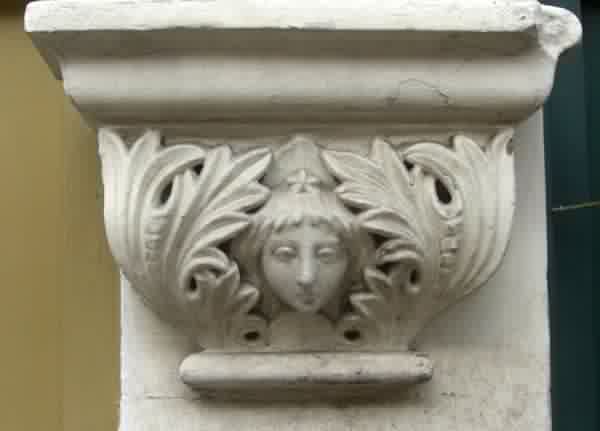
This carved head, one of three, adorns the front elevation of 5 Princes Street at eye level. They were almost certainly carved by John Swatridge as a demonstration of his stone carving skills.
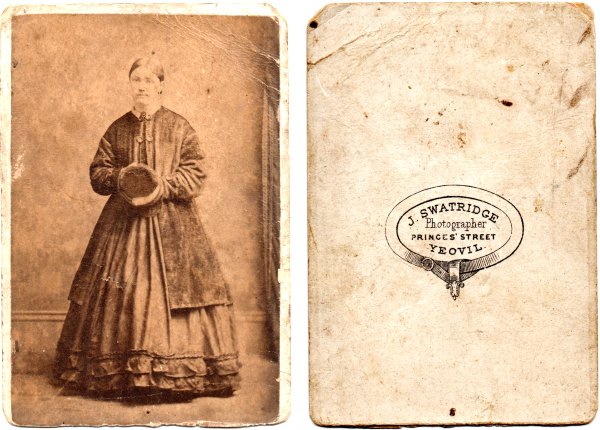
From my
collection
One of the earliest of John Swatridge's cartes de visite, judging by the lady's costume, the lack of background or props, and the early style of the back, it dates to around 1859 - the year cartes de visite were first introduced into England. Indeed, this is one of the very first cartes de visite to have appeared in Yeovil.
The carte would originally have had square corners - which were later rounded and the carte was trimmed along the bottom edge, presumably to fit into an album.
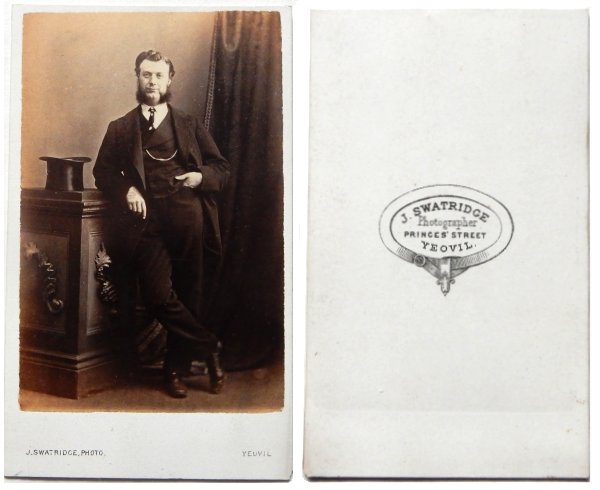
From my
collection
A carte de visite by John Swatridge and, from the back design, again dating to 1859.
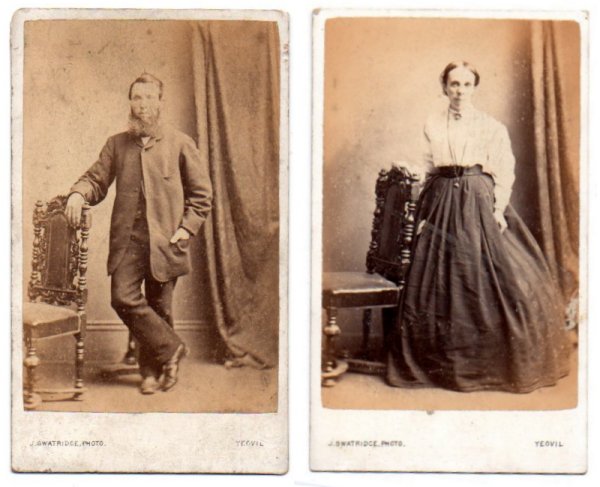
From my
collection
A pair of cartes de visite by John Swatridge of an un-named couple (from the same album). The design of the back is the same as the previous photograph. The cartes date to around 1860, when the full bell-shaped crinoline was beginning to flatten at the front. The cartes have square corners, the apparent rounding is due to wear.
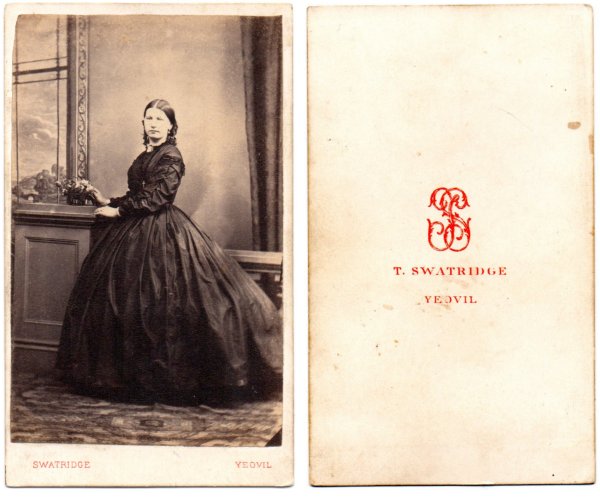
From my
collection
A carte de visite by Thomas Swatridge, with his own logo, dating to around 1860 when the full bell-shaped crinoline was beginning to flatten at the front. The lady's hair style of centre parting and ringlets at the rear is typical of this date. At this time, Thomas Swatridge was just eighteen years old and would leave Yeovil two years later.
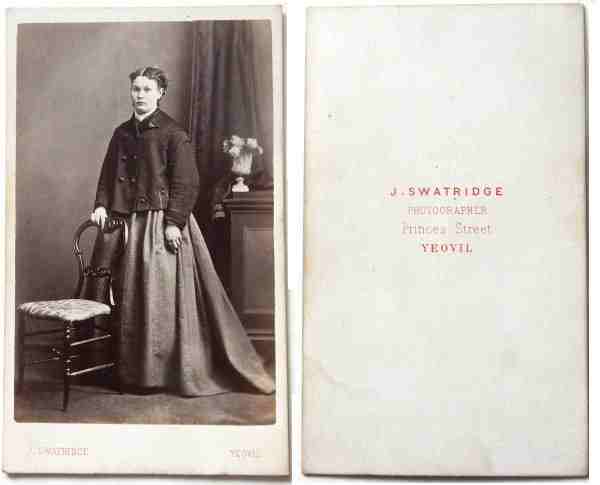
From my
collection
The lady's 'military style' jacket became fashionable very briefly in 1860, thereby helping to date this carte. The simple back design was probably an interim design before stocks of the following back design were received.
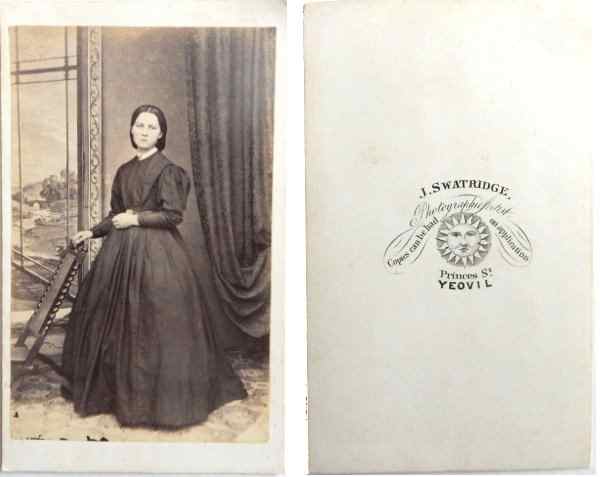
From my
collection
From the style of the lady's dress, this carte dates to around 1860 or 1861. Although not visible in this image, the original photograph features the lady's cheeks slightly rouged and her brooch at the neckline and her belt buckle lightly painted yellow to simulate gold. Note the elaborately-painted backdrop to the left masquerading as an open window with a view to the countryside.
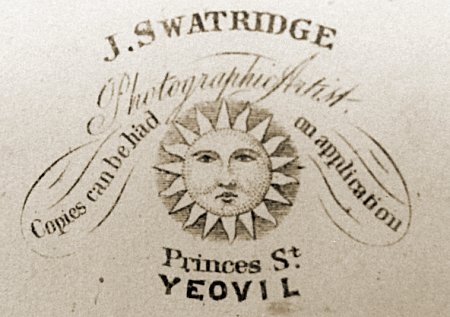
John Swatridge's logo enlarged from the portrait above, somewhat more elaborate than his earlier back design.

This colourised photograph
features in my
book 'Secret Yeovil'
A sepia photograph by John Swatridge of John Perry, circa 1863, holding a file and a cogged wheel he had presumably made himself. A note on the back of the photograph recorded "John Perry, Technical Blacksmith of Yeovil".

Courtesy of Bill
& Audrey
Robinson
A carte de visite by John Swatridge and, judging by the logo on the back, probably dating to the late 1860s.
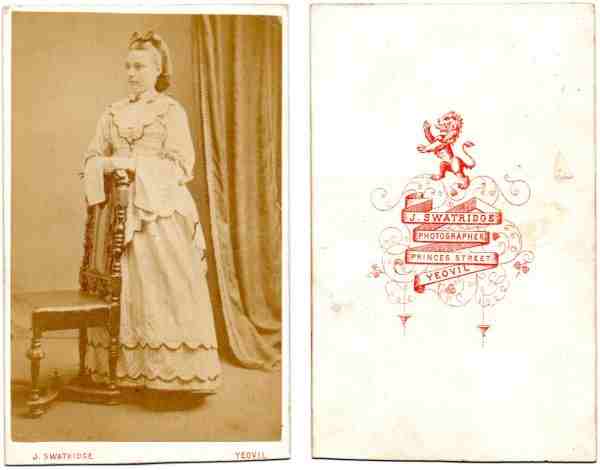
From my
collection
From the style of the lady's dress, combined with the square corners of the carte and the more elaborate logo on the reverse, the suggested date is around 1872. The bottom edge of the carte has been trimmed, presumably to fit in an album.
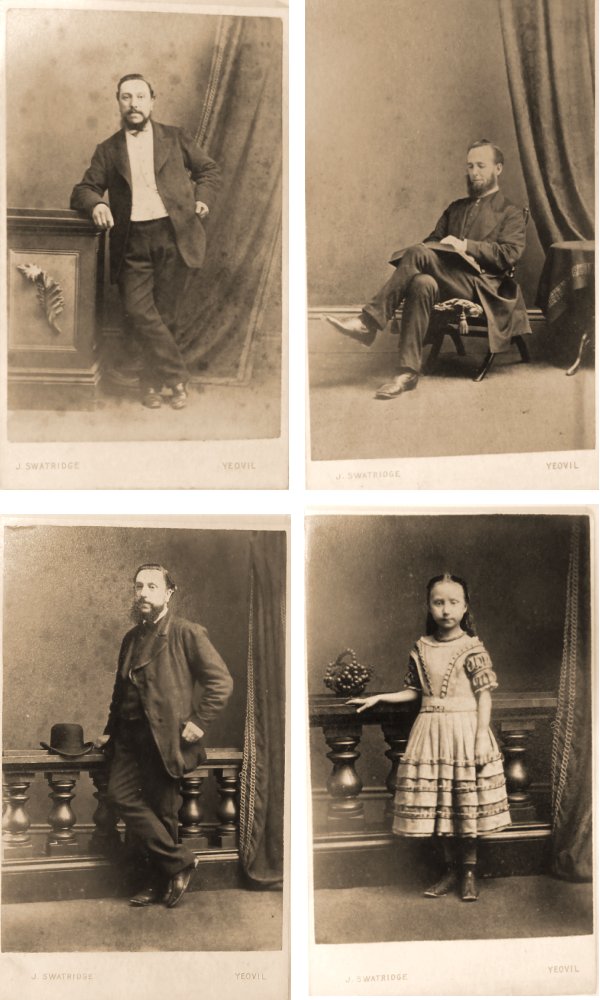
Courtesy of
South Somerset
Heritage
Collection
These four CDVs by John Swatridge all have backs identical to those above and below, therefore the suggested date is around 1872. The little girl is Alice Maud Harris, known as Maud (1872-1963).
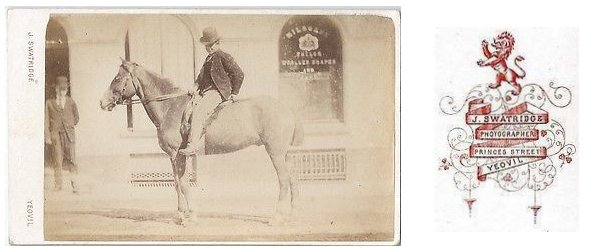
A Carte de Visite by John Swatridge, with the same back logo as above shown by its side.

Courtesy of
Deborah Eaton
Two cartes de visite by John Swatridge. The lady at left is thought to be Hester Gifford (1814-1896) and the younger woman may be her daughter. Again, from the style of the dress of the lady at the right, combined with the square corners, a date of around 1872 is suggested.
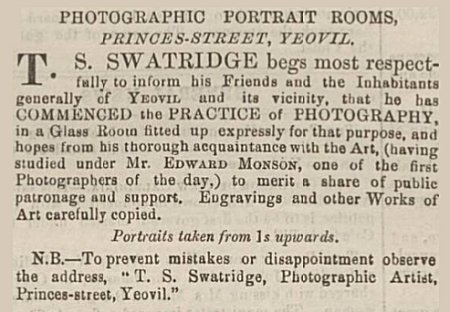
John's son, Thomas Sydenham Swatridge, was just seventeen years old and clearly operating from his father's shop when he began his photographic career.
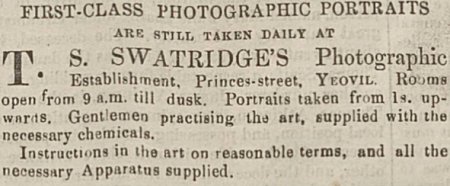
This advertisement appeared in the Yeovil edition of the Western Flying Post on 10 August 1858.
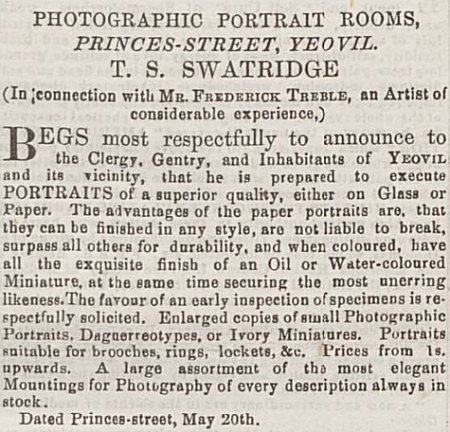
The announcement of the collaboration between Thomas Swatridge and artist Frederick Treble who would produce oil portraits based on Thomas' photographs ran in the Western Flying Post throughout May and June 1859. The partnership did not last long as the following year Thomas was collaborating with another artist - Mr Lawson (see below).
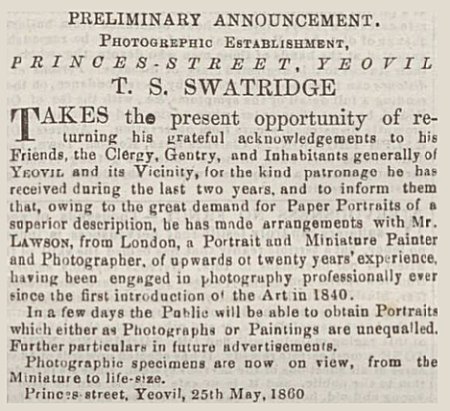
An advertisement in the 12 June 1860 edition of the Western Flying Post announcing the forthcoming collaboration between Thomas Swatridge and Mr Lawson.
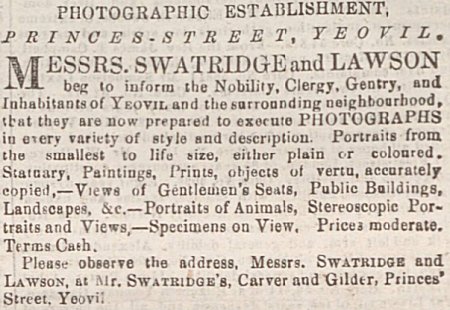
An advertisement in the 3 July 1860 edition of the Western Flying Post .
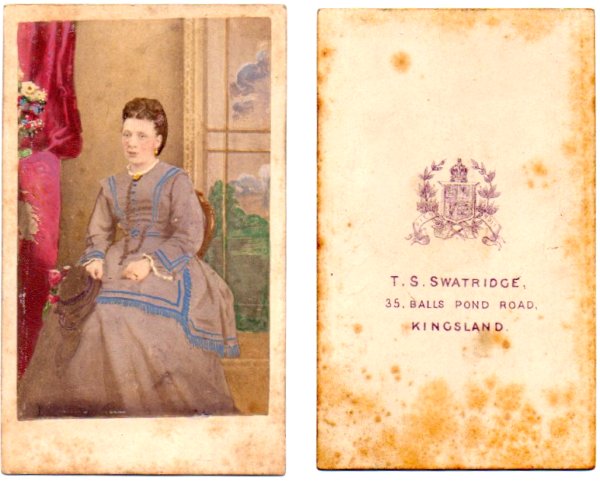
From my
collection
Thomas was at 35 Balls Pond Road from at least 1871 until 1877, thereby bracketing dates for this carte. It is an outstanding example of a hand-coloured carte of the period.
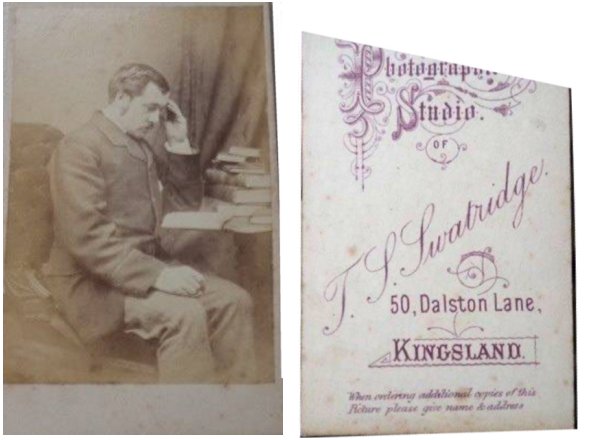
Courtesy of
Ali Salman
A carte de visite by Thomas Swatridge. The studio address of 50 Dalston Lane dates this carte to between 1877 and 1881.
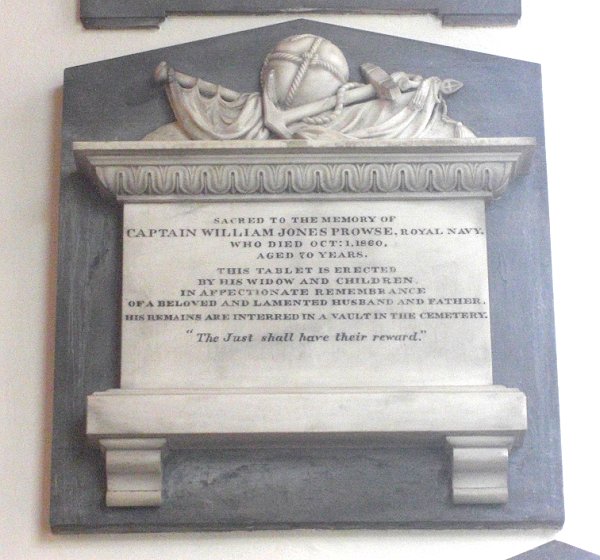
An example of John Swatridge's carved marble work - the memorial to Captain Prowse in St John's church. The cost of the memorial was £81 (just over £8,000 at today's value).